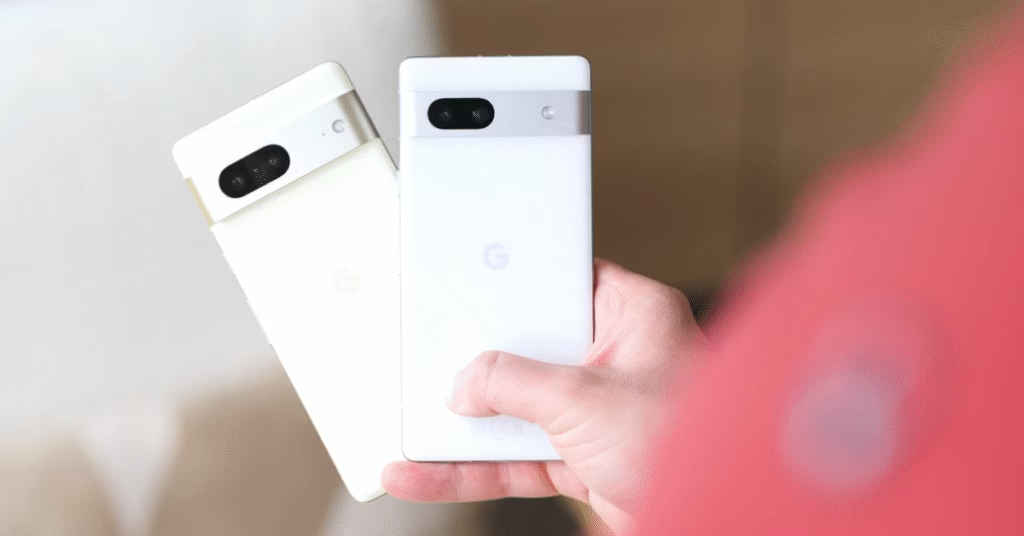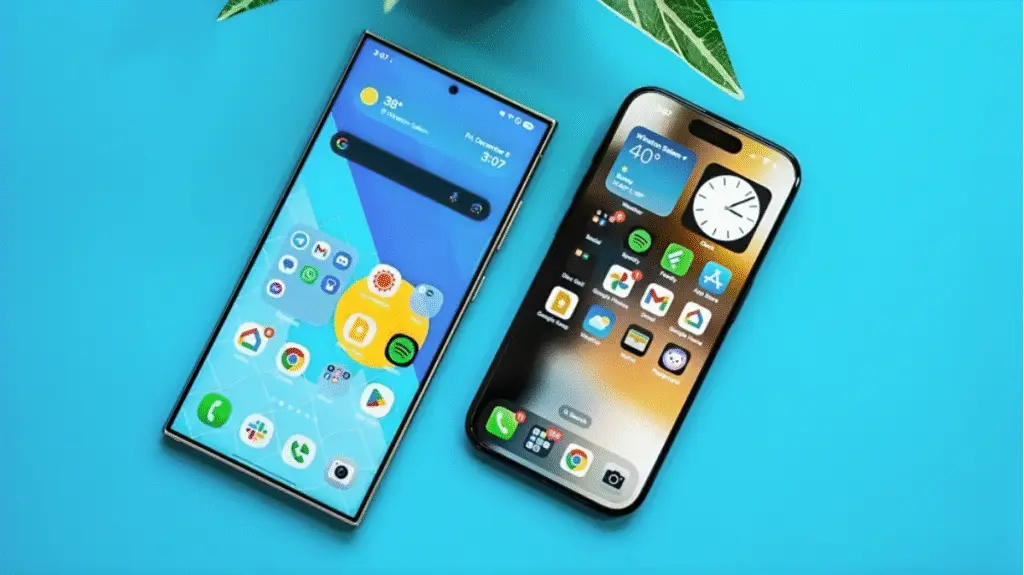
Google’s Pixel lineup has always been known for offering clean Android software, great cameras, and reliable performance. The Pixel 7 and Pixel 7a continue that tradition, but now the gap between the two phones has become narrower than ever. With almost identical specs and a design that looks nearly the same, many buyers are left wondering which one to choose. Let’s take a closer look at how both devices compare and where each of them stands out.
Design and Build Quality
At first glance, you’d struggle to tell these two phones apart. Both share Google’s signature design with the camera bar stretching across the back and the familiar matte frame. The Pixel 7a, however, is slightly smaller, featuring a 6.1-inch display compared to the Pixel 7’s 6.3-inch screen. It feels a bit more compact and comfortable to hold, though the bezels are thicker on all sides, making it look slightly less premium up close.
While Google claims the 7a’s camera bar is made of metal, in hand it feels more like plastic. That’s part of how Google keeps the price lower. Still, the overall look and feel are clean, modern, and unmistakably “Pixel.” The Pixel 7 remains a bit more refined with its slimmer bezels and slightly heavier, more solid feel.
Quick Comparison
| Specification | Google Pixel 7 | Google Pixel 7a |
|---|---|---|
| Display | 6.3″ AMOLED, 90Hz | 6.1″ OLED, 90Hz (60Hz default) |
| Chipset | Google Tensor G2 | Google Tensor G2 |
| RAM | 8GB | 8GB |
| Storage | 128GB / 256GB | 128GB |
| Main Camera | 50MP (Samsung GN1) | 64MP (new sensor) |
| Ultrawide Camera | 12MP | 13MP (slightly wider) |
| Front Camera | 10.8MP | 13MP |
| Video Recording | 4K @ 60fps | 4K @ 60fps |
| Battery | 4355mAh, 20W wireless | 4385mAh, 7.5W wireless |
| Water Resistance | IP68 | IP67 |
| Software Support | Until Oct 2027 | Until July 2028 |
| Build | Glass front (Gorilla Glass Victus), glass back (Gorilla Glass Victus), aluminum frame | Glass front (Gorilla Glass 3), aluminum frame, plastic back |
| Launch Price | $599 | $499 |
Disclaimer: Specs and prices may vary by region. Always confirm with official sources.
Display and Visual Experience
Both devices come with OLED panels running at up to 90Hz, delivering smooth animations and punchy colors. However, the Pixel 7a is tuned to 60Hz by default, and you’ll have to manually enable the smoother display option. Even then, it doesn’t feel quite as fluid as the Pixel 7, which handles motion better and reaches a higher peak brightness.
Despite that, both phones provide accurate colors, deep contrast, and a rich viewing experience. Whether you’re streaming videos or scrolling through social media, the visual quality is impressive for the price range. The difference is only noticeable when the two devices are placed side by side.
Performance and Hardware
Under the hood, both models use Google’s Tensor G2 processor, the same chip found in the flagship Pixel 7 Pro. That means everyday performance is practically identical. The 7a even gets an upgrade this year with 8GB of RAM, the same amount as the regular Pixel 7. Apps stay open longer, multitasking feels smoother, and gaming performance is solid for most titles.
The only limitation is in storage options. The Pixel 7a comes in one version with 128GB of storage, while the Pixel 7 can also be found with 256GB. If you often shoot videos, download games, or keep large files, the extra capacity might matter. Otherwise, both phones deliver very similar real-world speed and reliability.
Software and Updates
Google’s clean Android experience is one of the main reasons people buy Pixel phones, and both the Pixel 7 and 7a deliver exactly that. They ship with Android 13 and come with the same five-year support promise of three years of major Android upgrades and two additional years of security patches.
The Pixel 7 will receive updates until October 2027, while the 7a gets support until July 2028. That small difference means the cheaper model will technically be supported longer, though neither will likely get major features beyond Android 16. Still, for long-term users, that’s solid value.
Software features are mostly identical too. Both offer Face Unlock, the built-in Google One VPN, and smart tools powered by Tensor G2, such as real-time voice transcription and Live Translate. However, some minor features like cough and snore detection are missing on the Pixel 7a.
Camera Comparison
Cameras have always been Google’s strongest area, and this time the competition between the two devices is closer than ever. The Pixel 7a ditches the old Sony IMX363 sensor and adopts a new 64-megapixel main camera, while the Pixel 7 keeps its 50-megapixel Samsung GN1 sensor.
In practice, both cameras produce stunning photos. Google’s image processing ensures sharp detail, balanced exposure, and natural colors. The Pixel 7 tends to deliver slightly better depth and dynamic range, but you’d have to zoom in to notice. The Pixel 7a, on the other hand, captures slightly higher-resolution shots that look excellent in daylight.
The ultrawide cameras are almost identical, with the 7a offering a marginally wider field of view. Both phones handle video recording well, supporting 4K at 30fps on the main lens, though the Pixel 7 offers 60fps at 4K for smoother footage. Cinematic Blur mode, which creates that movie-like shallow depth effect, is missing on the 7a, but most users won’t miss it.
Overall, the Pixel 7 keeps a slight edge in image depth and low-light consistency, but the 7a’s camera system is surprisingly close for a phone that costs less.
Battery Life and Charging
Battery life between the two devices is nearly the same, with the Pixel 7a actually having a slightly larger 4,385mAh battery compared to the Pixel 7’s 4,355mAh. In daily use, both easily last a full day with moderate usage, even when the 90Hz display is enabled.
The real difference comes in charging. The Pixel 7a supports 18W wired charging and newly added 7.5W wireless charging, a welcome upgrade over its predecessor. However, the wireless speed is quite slow, taking a long time to fill the battery. The Pixel 7 charges faster, offering 21W wireless charging with the official Pixel Stand. Neither phone includes a charger in the box, which has become standard these days.
Durability and Extras
The Pixel 7 holds an IP68 water and dust resistance rating, while the 7a is rated at IP67. The difference isn’t huge, but technically, the Pixel 7 offers slightly better protection if you drop it in water. Both have Gorilla Glass on the front and aluminum frames, though the 7a’s back panel is made from a softer material that can pick up scratches a bit easier.
One nice surprise is that the 7a supports wireless charging, a feature that was missing on the 6a. It also offers face unlock, stereo speakers, and an always-on display, bringing it much closer to flagship territory.
Price and Value
This is where the Pixel 7a really shines. At its lower retail price, it provides nearly the same experience as the Pixel 7 for significantly less money. You’re getting the same processor, smooth performance, great cameras, and long-term updates. Unless you find a big discount on the Pixel 7, the 7a is simply the better deal for most people.
The Pixel 7, however, still makes sense for those who want the slightly more premium feel, faster wireless charging, better IP rating, and 256GB storage option. If you can grab it on sale, it becomes a more tempting choice.
Final Verdict
Choosing between the Pixel 7 and 7a isn’t easy and that’s a good thing. Google has finally made its affordable phone nearly as good as its flagship. The Pixel 7a delivers smooth performance, strong battery life, great cameras, and reliable software updates at a price that makes sense. The Pixel 7 edges ahead in small areas like build quality and camera depth, but the differences are too minor for most buyers to notice.
For most users, the 7a offers everything that makes a Pixel phone great, without the extra cost. It’s compact, powerful, and well-built, a perfect example of how Google’s A-series has matured into a true flagship alternative.
If you can find the regular Pixel 7 discounted, it might still be worth it for those few extra perks. Otherwise, the Pixel 7a is the smarter choice giving you flagship-level experience at a more comfortable price point.
See Also Google Pixel 7 Pro vs 8: Which One Fits Better in 2025?ra
FAQs (Google Pixel 7 vs 7a)
Is the Pixel 7a better than the Pixel 7?
The Pixel 7a offers nearly the same performance, software, and camera quality as the Pixel 7 at a lower price. Unless you need faster wireless charging or higher storage options, the 7a is the better deal for most users.
Does the Pixel 7a have wireless charging?
Yes, the Pixel 7a supports wireless charging for the first time in the A-series, though it’s limited to 7.5W. It’s slower than the Pixel 7’s 21W wireless charging speed.
Which phone has a better camera?
The Pixel 7 has a slightly better main camera sensor that produces deeper detail, especially in low light. However, the Pixel 7a’s 64MP camera delivers great results that are almost indistinguishable in everyday use.
How long will the Pixel 7 and 7a receive updates?
Both phones come with Google’s five-year support policy. The Pixel 7 will receive updates until October 2027, while the Pixel 7a will be supported until July 2028.
What are the main differences between the two phones?
The Pixel 7 has a brighter display, slimmer bezels, a higher IP rating, and faster wireless charging. The Pixel 7a, on the other hand, is more affordable, slightly smaller, and still delivers flagship-like performance.
Which one should I buy?
If you want a compact, affordable phone with flagship power, go for the Pixel 7a. If you prefer a slightly more premium build and faster charging, the Pixel 7 is a solid choice especially if you find it on sale.
